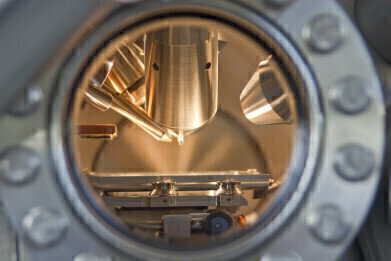-
 Pic 1. Senior Research Fellow, Dr David Scurr (behind) and lead academic Professor Morgan Alexander (foreground) looking at results obtained from the Time of Flight Ion Mass Spectrometer (ToF -SIMS in background)
Pic 1. Senior Research Fellow, Dr David Scurr (behind) and lead academic Professor Morgan Alexander (foreground) looking at results obtained from the Time of Flight Ion Mass Spectrometer (ToF -SIMS in background) -
 pic 2 only use if room make picture 1 as big as poss. caption: Close up inside the ToF-SIMS
pic 2 only use if room make picture 1 as big as poss. caption: Close up inside the ToF-SIMS
News & Views
New bacteria resistant materials discovered
Oct 10 2012
A new class of polymers found to be resistant to bacterial attachment, discovered by scientists at the University of Nottingham, could lead to a significant reduction in hospital infections and medical device failures currently thought to cost the NHS £1bn a year. Affecting many commonly used devices including urinary and venous catheters, bacteria form communities known as biofilms. This ‘strength in numbers approach’ protects them against the bodies’ natural defences and antibiotics.
The research,* led by Professor Morgan Alexander, and Professor Martyn Davies in the School of Pharmacy and Professor Paul Williams in the School of Molecular Medical Sciences at Nottingham, have shown that when applied to surfaces of devices, these new polymers can repel bacteria and prevent them forming biofilms. The studies were supported by a £1.3m four year Translation Award from the Wellcome Trust.
Discovery of the new materials was made with the help of experts from the Massachusetts Institute of Technology (MIT) — who initially developed the process by which thousands of unique polymers can now be screened simultaneously.
Professor Alexander said: “This is a major scientific breakthrough — we have discovered a new group of structurally related materials that dramatically reduce the attachment of pathogenic bacteria (Pseudomonas aeruginosa, Staphylococcus aureus and Escherichia coli). We could not have found these materials using the current understanding of bacteria-surface interactions. The technology developed with the help of MIT means that hundreds of materials could be screened simultaneously to reveal new structure-property relationships. In total thousands of materials were investigated using this high throughput materials discovery approach leading to the identification of novel materials resisting bacterial attachment. This could not have been achieved using conventional techniques.”
Next steps are looking toward the manufacturing of these coatings for clinical assessment and the inventors are said to be in early stage discussions with a number of medical device companies.
*Results published in Nature Biotechnology, August 12.
Digital Edition
Lab Asia 31.2 April 2024
April 2024
In This Edition Chromatography Articles - Approaches to troubleshooting an SPE method for the analysis of oligonucleotides (pt i) - High-precision liquid flow processes demand full fluidic c...
View all digital editions
Events
May 05 2024 Seville, Spain
InformEx Zone at CPhl North America
May 07 2024 Pennsylvania, PA, USA
May 14 2024 Oklahoma City, OK, USA
May 15 2024 Birmingham, UK
May 21 2024 Lagos, Nigeria






.jpg)










